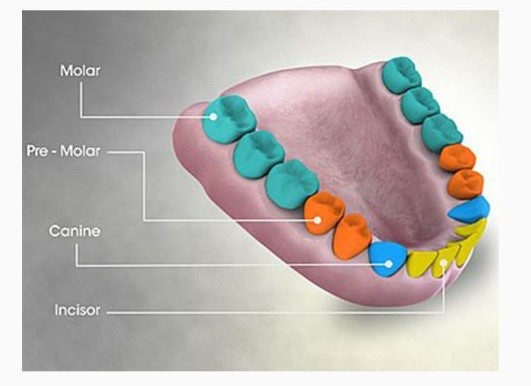general
General dentistry is a branch of medical science specializing in the diagnosis, prevention, and treatment of dental and gum issues. General dentistry is often regarded as the starting point and the primary area of dental and gum treatment, aiming to provide quality services to individuals across all dental areas. Overall, general dentistry is considered a crucial first step in the prevention, diagnosis, and treatment of dental and gum issues. By regularly visiting a dentist, individuals can protect their oral and dental health.
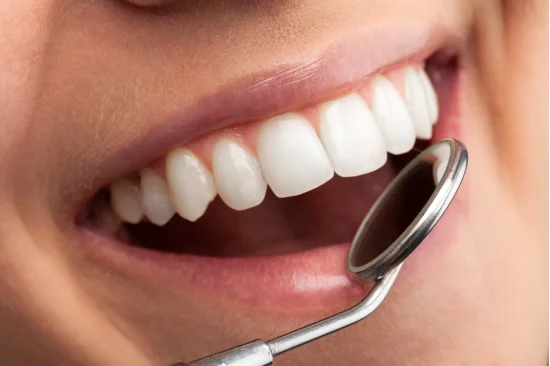
General Dentistry
In order to diagnose the health of teeth and gums, regular dental examination should be done. By doing this, existing problems can be quickly diagnosed and treatments can be planned and implemented to solve them. Early diagnosis is very important in oral and dental diseases. The optimal period for routine dental examinations is once every 6 months.
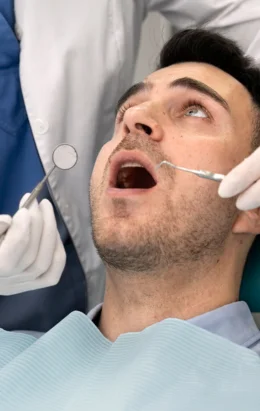
Root canal therapy is a process in dentistry in which the dentist, after removing tooth decay, finds the tooth canals and drains the infection, nerves and capillaries inside the canal. In completing the steps of denervation, the dentist, after washing and cleaning the canals of the teeth, shapes them and fills them with gutta-percha.
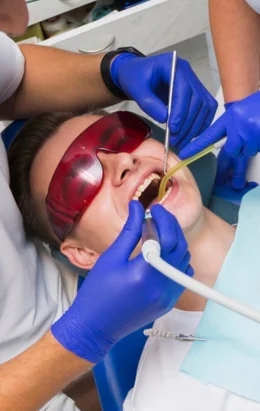
One of the important steps in the treatment of caries and restoration of damaged teeth. When the tooth is damaged due to decay or fracture, the dentist restores the tooth permanently or temporarily using appropriate techniques and materials.
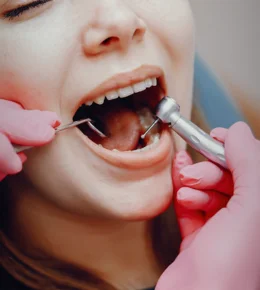
One of the fastest ways to get rid of the pain of a damaged tooth is tooth extraction. But today, this process is used not only to get rid of pain, but also for other things.





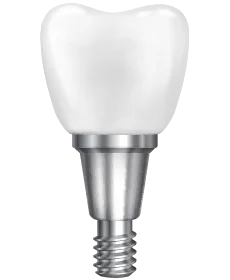
The stages of receiving services

Search for the service you want or choose from the available services.

In the appointment booking section, select and register your desired appointment.

After searching and registering your reservation, your confirmation will be announced via SMS and you can visit the clinic on the reserved date.
Frequent questions
Visiting the dentist regularly helps maintain oral health, prevent oral diseases, and detect dental problems early. Also, timely treatments can prevent the infection from spreading to other parts of the body.
Our dentists use special materials for painless tooth extraction. However, pain and discomfort may be felt for a few days after surgery, which is relieved by prescribed medications.
Nerve extraction is necessary when the depth of decay or damage to the tooth nerve reaches and deep infection or inflammation occurs that cannot be cured by filling the tooth.
Regular brushing and flossing, eating healthy foods, avoiding sugary foods, and regular dental check-ups help maintain your oral health.
After a tooth extraction, you should follow your dentist’s post-surgery instructions, including using medications and maintaining oral hygiene.
All about tooth extraction
- Description of tooth extraction
- Some reasons for tooth extraction
- Types of tooth extraction methods
- Steps of tooth extraction
- Description of wisdom tooth extraction
- Description of anterior tooth extraction
- Description of wisdom tooth extraction
- Description of broken tooth extraction
- Description of tooth extraction during pregnancy
- The condition of teeth and teeth after tooth extraction
- Complications of tooth extraction
- How to take care of teeth after extraction?
- How is tooth extraction with laser?
Description of tooth extraction
Permanent teeth hold a special place in our lives, playing a crucial role in speaking, eating, and the aesthetics of our face. Losing an adult tooth can jeopardize dental and gum health, forcing us to face challenges like facial sagging, gum infections, tooth decay, and more. Sometimes, extracting a tooth is the best option to maintain the health of the remaining teeth and gums. This is because if the tooth remains in place, it may pose greater, more serious risks to your other teeth. For instance, when tooth decay reaches its maximum extent and cannot be treated with a root canal, extraction is necessary, and replacement options like dental implants should be considered.
Some reasons for tooth extraction
- infection
- Periodontal disease
- Density of teeth and orthodontic treatment
- Tooth damage or injury
- A baby tooth that did not fall out on time
- Hidden and semi-hidden teeth
- Tooth placement in the wrong place
Types of tooth extraction methods
1 – simple drag
2- Partial pulling
3- Pulling with surgery
4- Tooth extraction using laser
Steps of tooth extraction
The stages of tooth extraction are usually different according to the type of tooth and its position. For example, removing a wisdom tooth is completely different from a decayed and damaged tooth and may require surgery. But usually, this method has several main steps that we will explain below.
- Anesthetize the tooth
- Loosening of gum tissue
- Applying sterile gas
- Separating the tooth from the gum
Description of wisdom tooth extraction
Wisdom teeth are the last teeth to emerge in the jaw. These teeth are located at the back of the upper and lower jaws and are also known as the third molars. When a wisdom tooth is healthy, grows correctly in the proper alignment, and has no issues with contact with the adjacent and opposing teeth, there is no need to extract it. In fact, it can be quite beneficial, acting as an auxiliary tooth in the mouth without any adverse effects. However, if the tooth is impacted, trapped in the jaw, causes dental cysts, infection, and jawbone pain, or puts pressure on other teeth due to insufficient space for growth, it must be removed. Extracting a wisdom tooth is the most challenging type of tooth extraction since accessing this tooth is very difficult for the dentist, and the patient may experience pain and discomfort for some time after the extraction.
Description of anterior tooth extraction
Anterior teeth include eight teeth located in the front and sides of the jaw, that is, including 4 teeth in the upper jaw and 4 teeth in the lower jaw. The main task of these teeth, which are also known as incisors, is to grab and cut food. As you know, the front teeth are usually the first teeth that start to grow in humans, so that the front milk teeth sprout from about 5 months of age and the permanent type from six years of age.
Description of wisdom tooth extraction
These teeth have larger surfaces and are responsible for chewing food. Unlike the grooves and ridges found on the surfaces of posterior teeth, such features are absent in anterior teeth; similarly, molars are not as sharp and cutting as anterior teeth. The anatomy of posterior teeth is somewhat more complex than that of anterior teeth due to the additional roots and canals that posterior teeth typically have. Although the number of roots may vary among individuals, the general anatomy of posterior teeth is as follows:
• Upper first premolar teeth with two roots
• Upper second premolar teeth with one or two roots
• Lower first and second premolar with only one root
• The 1st, 2nd and 3rd upper molars have three roots
• Lower molars 1, 2 and 3, two roots
Description of broken tooth extraction
Sometimes, a tooth may break due to excessive decay, trauma, or weakness of the tooth’s nerves. In such a situation, if the dentist is able to preserve the structure of the tooth, he will treat it and return it to its natural form with the help of dental laminate, dental veneer or dental composite. But in situations where the amount of fracture and damage is too much, the dentist will have to extract the tooth. The extraction of a broken tooth will not be much different from the extraction of a normal tooth in terms of the process.
Description of tooth extraction during pregnancy
Tooth extraction during pregnancy can be checked because to check the condition of the teeth, X-ray images of the mouth and teeth are needed. If you are in the first 3 months of your pregnancy, your gynecologist may suggest you not to do this because the radiation is harmful for the child you have inside you.
The condition of teeth and teeth after tooth extraction
• Dentists recommend that you eat liquid and soft foods and avoid irritating foods in the first week after extraction.
• Recovery after tooth extraction may take some time and the most important recovery process happens in the first three days.
• After the anesthesia wears off, pain and discomfort may be felt again, so dentists recommend the use of certain medications to resolve this issue.
• The place of tooth extraction is accompanied by bleeding for several hours (about 4 hours) and sterile gas remains on it until the bleeding stops.
Complications of tooth extraction
Tooth extraction is always associated with problems such as pain, inflammation, bruising, bleeding, and infection, all of which are resolved with time and the use of anti-inflammatory and pain-relieving drugs. But some of these problems are a bit troublesome and endanger the health of the rest of the teeth. For example, after a tooth is extracted, other teeth are more likely to move, resulting in misalignment of teeth and changes in the bite.
• Cavity dryness: When a tooth is extracted, a blood clot naturally forms in the area where the tooth used to be. Sometimes this blood clot disappears prematurely and this can lead to dry cavity.
• Bone death: Usually, those who have a history of radiation therapy in the head and neck area are at risk of developing a disease called osteoradionecrosis after tooth extraction. This condition is caused by the death of the bone in the area of the extracted tooth due to damage to the blood vessels.
• Ulcers in the mouth: If you do not pay attention to the advice of dentists not to eat for a few hours after surgery, due to the numbness of the mouth, you may unconsciously bite your tongue or the corner of your mouth and cause an ulcer.
Numbness of the lip and chin: If you do not consult a specialist to extract the lower teeth (especially the wisdom teeth), the inferior alveolar nerve may be damaged and lead to numbness of the lip and chin for a few days to a few months. In some rare cases, this numbness may last forever.
• Bone fracture: In some rare cases, a jaw bone fracture may occur during tooth extraction.
How to take care of teeth after extraction?
• After tooth extraction within 24 hours, you can gradually start your normal activities.
• Avoid spitting and washing your mouth vigorously for the first 24 hours.
Immediately after tooth extraction, put an ice pack on that area (apply ice for 10 minutes and remove it for 10 minutes). This will prevent it from swelling.
• To prevent infection, after 24 hours, swish salt water solution or washing serum inside your mouth.
• Brush and floss regularly.
• Be careful not to open the cut and make it bleed.
• In the first few days, it is better to use soft foods such as soup, yogurt, potatoes, jelly, etc.
• You can follow your diet, but avoid eating hard foods.
• The recovery period is usually a few days, sometimes up to two weeks.
• If you experience unusual symptoms, contact your doctor immediately.
How is tooth extraction with laser?
The laser consists of a very narrow and focused beam, which when it hits the tissue, causes it to be separated. They use this tool to shave soft and hard tissues, which makes the treatment process very easy.
• Be careful not to open the cut and make it bleed.
• In the first few days, it is better to use soft foods such as soup, yogurt, potatoes, jelly, etc.
• You can follow your diet, but avoid eating hard foods.
• The recovery period is usually a few days, sometimes up to two weeks.
• If you experience unusual symptoms, contact your doctor immediately.

